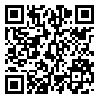Mon, May 12, 2025
[Archive]
Volume 34, Issue 1 (2-2020)
Med J Islam Repub Iran 2020 |
Back to browse issues page
Download citation:
BibTeX | RIS | EndNote | Medlars | ProCite | Reference Manager | RefWorks
Send citation to:



BibTeX | RIS | EndNote | Medlars | ProCite | Reference Manager | RefWorks
Send citation to:
Motazedian N, Sayadi M, Beheshti S, Zarei N, Ghaderi J. High risky behavior and HIV/AIDS knowledge amongst street children in Shiraz, Iran. Med J Islam Repub Iran 2020; 34 (1) :952-957
URL: http://mjiri.iums.ac.ir/article-1-4846-en.html
URL: http://mjiri.iums.ac.ir/article-1-4846-en.html
Shiraz Transplant Research Center, Shiraz University of Medical Sciences, Shiraz, Iran , nmotazedi@sums.ac.ir
Abstract: (1647 Views)
Background: Street children around the world are accompanying a wide range of risky behaviors. The most common ones include risky sexual behavior, substance and alcohol abuse, and violence. This study aimed to assess risk behaviors and HIV knowledge of street children in Shiraz.
Methods: A total of 329 street children (7-18 years of age who spend days or nights on streets with or without their family for earning money) were interviewed through 2014-2016 in Shiraz. Data were collected through a structured interview about high-risk behaviors and HIV/AIDS Knowledge based on a form and questionnaire. Street children were asked to identify HIV/AIDS mode of transmission. All correct answers were scored as one (1), and incorrect, “don’t know” responses and no responses scored as zero. The data were analyzed by SPSS software 16 (SPSS, Inc. Chicago, USA) using the Independent t-test and chi-square test, and Pearson's correlation test. P value< 0.05 was considered as statistically significant
Results: The mean ± SD age was 13.46±3.09. A total of 86.6% of them were boys. A total of 97.6% of them reported staying with their parents. Street children reported sleeping place as follow: with their parents (n=312, 94.8%), sharing accommodation with other kids (n=13, %4), sleeping in parks (n=2, 7%), and one with relatives. The frequency of smoking, alcohol drinking, and drug abuse were 35 (10.6%), 47 (14. 3%), and 6 (1.8%) respectively. A total of 43 (13.1%) street children reported sexual activity, among them 30 (9.1%) had sexual activity without a condom. Mean ± SD HIV/AIDS knowledge scoring of street children was, 4.1±3.9.
Conclusion: Special programs should be implemented in order to reduce high-risk behavior among street children. Intervention should include increasing awareness about alcohol and drug abuse, HIV/AIDS knowledge, sexual and verbal abuse through an organized system with the help of peer education.
Methods: A total of 329 street children (7-18 years of age who spend days or nights on streets with or without their family for earning money) were interviewed through 2014-2016 in Shiraz. Data were collected through a structured interview about high-risk behaviors and HIV/AIDS Knowledge based on a form and questionnaire. Street children were asked to identify HIV/AIDS mode of transmission. All correct answers were scored as one (1), and incorrect, “don’t know” responses and no responses scored as zero. The data were analyzed by SPSS software 16 (SPSS, Inc. Chicago, USA) using the Independent t-test and chi-square test, and Pearson's correlation test. P value< 0.05 was considered as statistically significant
Results: The mean ± SD age was 13.46±3.09. A total of 86.6% of them were boys. A total of 97.6% of them reported staying with their parents. Street children reported sleeping place as follow: with their parents (n=312, 94.8%), sharing accommodation with other kids (n=13, %4), sleeping in parks (n=2, 7%), and one with relatives. The frequency of smoking, alcohol drinking, and drug abuse were 35 (10.6%), 47 (14. 3%), and 6 (1.8%) respectively. A total of 43 (13.1%) street children reported sexual activity, among them 30 (9.1%) had sexual activity without a condom. Mean ± SD HIV/AIDS knowledge scoring of street children was, 4.1±3.9.
Conclusion: Special programs should be implemented in order to reduce high-risk behavior among street children. Intervention should include increasing awareness about alcohol and drug abuse, HIV/AIDS knowledge, sexual and verbal abuse through an organized system with the help of peer education.
Type of Study: Original Research |
Subject:
Epidemiology
Send email to the article author
| Rights and permissions | |
 |
This work is licensed under a Creative Commons Attribution-NonCommercial 4.0 International License. |








